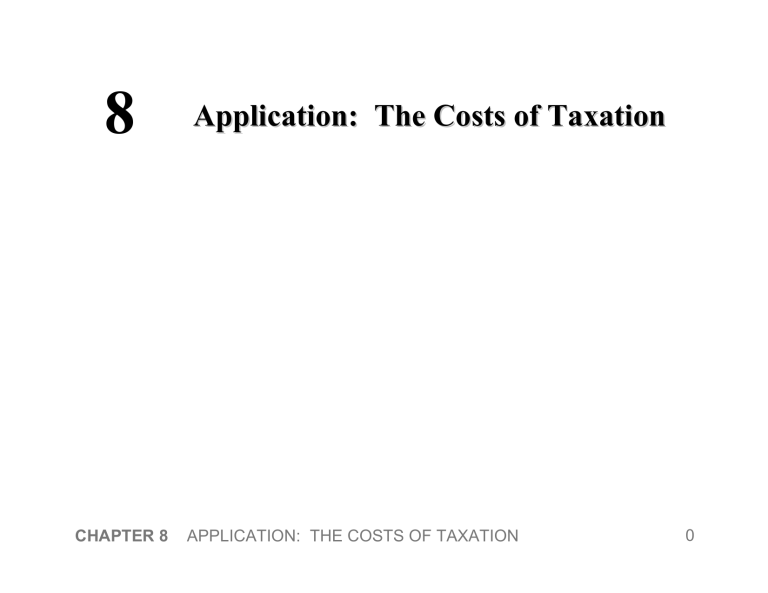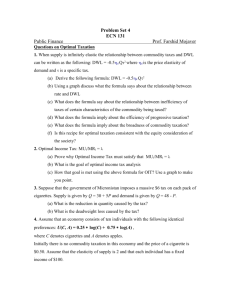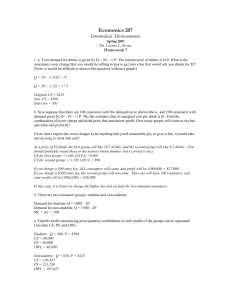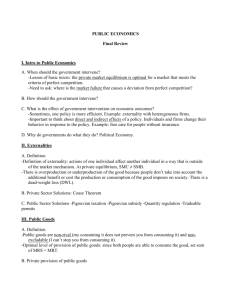
8
Application: The Costs of Taxation
CHAPTER 8 APPLICATION: THE COSTS OF TAXATION 0
In this chapter, look for the answers to these questions:
How does a tax affect consumer surplus, producer surplus, and total surplus?
What is the deadweight loss of a tax?
What factors determine the size of this deadweight loss?
How does tax revenue depend on the size of the tax?
CHAPTER 8 APPLICATION: THE COSTS OF TAXATION 1
Review from Chapter 6:
A tax is a wedge between the price buyers pay and the price sellers receive.
A tax raises the price buyers pay and lowers the price sellers receive.
A tax reduces the quantity bought & sold.
These effects are the same whether the tax is imposed on buyers or sellers, so we do not make this distinction in this chapter.
CHAPTER 8 APPLICATION: THE COSTS OF TAXATION 2
The Effects of a Tax
P
With no tax, eq’m price is P
E and quantity is Q
E
.
Govt imposes a tax of $ T per unit.
P
B
Size of tax = $ T
S
P
E
The price buyers pay is P
B
, the price sellers receive is P
S
, and quantity is Q
T
.
P
S
Q
T
Q
E
D
Q
CHAPTER 8 APPLICATION: THE COSTS OF TAXATION 3
The Effects of a Tax
P
The tax generates revenue equal to
$ T x Q
T
.
Size of tax = $ T
S
P
B
P
E
P
S
D
Q
T
CHAPTER 8 APPLICATION: THE COSTS OF TAXATION
Q
E
Q
4
The Effects of a Tax
Next, we use the tools of welfare economics to measure the gains and losses from a tax.
We will determine consumer surplus (CS), producer surplus (PS), tax revenue, and total surplus with and without the tax.
Tax revenue is included in total surplus, because tax revenue can be used to provide services such as roads, police, public education, etc.
CHAPTER 8 APPLICATION: THE COSTS OF TAXATION 5
The Effects of a Tax
P
Without a tax,
CS = A + B + C
PS = D + E + F
Tax revenue = 0
A
B
Total surplus
= CS + PS
= A + B + C
+ D + E + F
P
E
F
D
C
E
Q
T
CHAPTER 8 APPLICATION: THE COSTS OF TAXATION
Q
E
S
D
Q
6
The Effects of a Tax
P
With the tax,
CS = A
PS = F
Tax revenue
= B + D
Total surplus
= A + B
+ D + F
The tax causes total surplus to fall by C + E
P
B
P
S
A
F
B
D
Q
T
C
E
Q
E
CHAPTER 8 APPLICATION: THE COSTS OF TAXATION
S
D
Q
7
The Effects of a Tax
P
C + E is called the deadweight loss
(DWL) of the tax, the fall in total surplus that results from a market distortion, such as a tax.
P
B
P
S
A
F
B
D
C
E
S
D
Q
T
CHAPTER 8 APPLICATION: THE COSTS OF TAXATION
Q
E
Q
8
About the Deadweight Loss
P
Because of the tax, the units between
Q
T and sold.
Q
E are not
P
B
The value of these units to buyers is greater than the cost of producing them, so the tax has prevented some mutually beneficial trades.
P
S
Q
T
Q
E
CHAPTER 8 APPLICATION: THE COSTS OF TAXATION
S
D
Q
9
1
:
A.
Compute
CS, PS, and total surplus without a tax.
B.
If $100 tax per ticket, compute
CS, PS, tax revenue, total surplus, and DWL.
P
The market for airplane tickets
$ 400
350
300
250
200
150
100
50
0
S
D
0 25 50 75 100 125
Q
10
P
The market for airplane tickets
CS
= ½ x $200 x 100
= $10,000
$ 400
350
300
S
PS
= ½ x $200 x 100
= $10,000
250
P = 200
150 total surplus
= $10,000 + $10,000
= $20,000
100
50
0
D
0 25 50 75 100 125
Q
11
P
A $100 tax on airplane tickets
CS
= ½ x $150 x 75
= $5,625
PS = $5,625 tax revenue
= $100 x 75
= $7,500 total surplus
= $18,750
DWL = $1,250
$ 400
350
300
P
B
= 250
200
P
S
= 150
100
50
0
0 25 50 75 100 125
S
D
Q
12
What Determines the Size of the DWL?
The govt needs tax revenue to finance roads, schools, police, etc., so it must tax some goods and services.
Which ones? One answer is that govt should tax the goods or services with the smallest DWL.
So when is the DWL small vs. large? Turns out it depends on the elasticities of supply and demand.
Recall: The price elasticity of demand (or supply) measures how much quantity demanded
(or supplied) changes when the price changes.
CHAPTER 8 APPLICATION: THE COSTS OF TAXATION 13
DWL and the Elasticity of Supply
When supply is inelastic, the DWL of a tax is small.
P
S
Size of tax
CHAPTER 8 APPLICATION: THE COSTS OF TAXATION
D
Q
14
DWL and the Elasticity of Supply
P
S
The more elastic is supply, the larger is the DWL.
Size of tax
CHAPTER 8 APPLICATION: THE COSTS OF TAXATION
D
Q
15
DWL and the Elasticity of Demand
When demand is inelastic, the DWL of a tax is small.
P
S
Size of tax
D
CHAPTER 8 APPLICATION: THE COSTS OF TAXATION
Q
16
DWL and the Elasticity of Demand
P
S
The more elastic is demand, the larger is the DWL.
Size of tax
D
Q
CHAPTER 8 APPLICATION: THE COSTS OF TAXATION 17
Why Elasticity Affects the Size of DWL
A tax distorts the market outcome: consumers buy less and producers sell less, so eq’m Q is below the surplus-maximizing quantity.
Elasticity measures how much buyers and sellers respond to changes in price, and therefore determines how much the tax distorts the market outcome.
CHAPTER 8 APPLICATION: THE COSTS OF TAXATION 18
A C T I V E L E A R N I N G
2
:
Elasticity and DWL of a tax
Would the DWL of a tax be larger if the tax were on
A.
Rice Krispies or sunscreen?
B.
Hotel rooms in the short run or hotel rooms in the long run?
C.
Groceries or meals at fancy restaurants?
19
How Big Should the Government Be?
A bigger government provides more services, but requires higher taxes, which cause DWL.
The larger the DWL from taxation, the greater the argument for smaller government.
The tax on labor income is especially important; it’s the biggest source of govt revenue.
For many workers, the marginal tax rate (the tax on the last dollar of earnings) is almost 50%.
How big is the DWL from this tax?
It depends on elasticity….
CHAPTER 8 APPLICATION: THE COSTS OF TAXATION 20
How Big Should the Government Be?
If labor supply is inelastic, then this DWL is small.
Some economists believe labor supply is inelastic, arguing that most workers work full time regardless of the wage.
CHAPTER 8 APPLICATION: THE COSTS OF TAXATION 21
How Big Should the Government Be?
Other economists believe labor taxes are highly distorting because some groups of workers have elastic supply and can respond to incentives:
•
Many workers can adjust their hours, e.g.
by working overtime.
•
Many families have a 2 nd earner with discretion over whether and how much to work.
•
Many elderly choose when to retire based on the wage they earn.
• Some people work in the “underground economy” to evade high taxes.
CHAPTER 8 APPLICATION: THE COSTS OF TAXATION 22
The Effects of Changing the Size of the Tax
Policymakers often change taxes, raising some and lowering others.
What happens to DWL and tax revenue when taxes change? We explore this next….
CHAPTER 8 APPLICATION: THE COSTS OF TAXATION 23
DWL and the Size of the Tax
P
Initially, the tax is
T per unit.
Doubling the tax causes the DWL to more than double.
2 T T new
DWL
S initial
DWL
D
Q
Q
2
Q
1
CHAPTER 8 APPLICATION: THE COSTS OF TAXATION 24
DWL and the Size of the Tax
P
Initially, the tax is
T per unit.
Tripling the tax causes the DWL to more than triple.
3 T new
DWL
T
S initial
DWL
D
Q
Q
3
Q
CHAPTER 8 APPLICATION: THE COSTS OF TAXATION
1
25
DWL and the Size of the Tax
Summary
When a tax increases,
DWL rises even more.
DWL
CHAPTER 8 APPLICATION: THE COSTS OF TAXATION
Tax size
26
Revenue and the Size of the Tax
When the tax is small, increasing it causes tax revenue to rise.
P
B
P
B
P
S
2 T T
P
S
P
S
D
Q
Q
2
Q
1
CHAPTER 8 APPLICATION: THE COSTS OF TAXATION 27
Revenue and the Size of the Tax
P
B
P
B
P
S
When the tax is larger, increasing it causes tax revenue to fall.
P
S
P
S
3 T 2 T
D
Q
Q
3
Q
2
CHAPTER 8 APPLICATION: THE COSTS OF TAXATION 28
Revenue and the Size of the Tax
The Laffer curve shows the relationship between the size of the tax and tax revenue.
Tax revenue
The Laffer curve
CHAPTER 8 APPLICATION: THE COSTS OF TAXATION
Tax size
29



